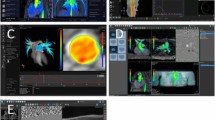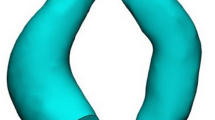Abstract
To assess spatial and temporal pressure characteristics in patients with repaired aortic coarctation compared to young healthy volunteers using time-resolved velocity-encoded three-dimensional phase-contrast magnetic resonance imaging (4D flow MRI) and derived 4D pressure difference maps. After in vitro validation against invasive catheterization as gold standard, 4D flow MRI of the thoracic aorta was performed at 1.5T in 13 consecutive patients after aortic coarctation repair without recoarctation and 13 healthy volunteers. Using in-house developed processing software, 4D pressure difference maps were computed based on the Navier–Stokes equation. Pressure difference amplitudes, maximum slope of pressure amplitudes and spatial pressure range at mid systole were retrospectively measured by three readers, and twice by one reader to assess inter- and intraobserver agreement. In vitro, pressure differences derived from 4D flow MRI showed excellent agreement to invasive catheter measurements. In vivo, pressure difference amplitudes, maximum slope of pressure difference amplitudes and spatial pressure range at mid systole were significantly increased in patients compared to volunteers in the aortic arch, the proximal descending and the distal descending thoracic aorta (p < 0.05). Greatest differences occurred in the proximal descending aorta with values of the three parameters for patients versus volunteers being 19.7 ± 7.5 versus 10.0 ± 2.0 (p < 0.001), 10.9 ± 10.4 versus 1.9 ± 0.4 (p = 0.002), and 8.7 ± 6.3 versus 1.6 ± 0.9 (p < 0.001). Inter- and intraobserver agreements were excellent (p < 0.001). Noninvasive 4D pressure difference mapping derived from 4D flow MRI enables detection of altered intraluminal aortic pressures and showed significant spatial and temporal changes in patients with repaired aortic coarctation.


Similar content being viewed by others
References
Tronc F, Curtil A, Robin J, Ninet J, Champsaur G (1997) Coarctation of the aorta and its surgical treatment. Arch Mal Coeur Vaiss 90:1729–1736
Hamdan MA, Maheshwari S, Fahey JT, Hellenbrand WE (2001) Endovascular stents for coarctation of the aorta: initial results and intermediate-term follow-up. J Am Coll Cardiol 38:1518–1523
Soulen RL, Donner RM, Capitanio M (1987) Postoperative evaluation of complex congenital heart disease by magnetic resonance imaging. Radiographics 7:975–1000
Oliver JM, Gallego P, Gonzalez A, Aroca A, Bret M, Mesa JM (2004) Risk factors for aortic complications in adults with coarctation of the aorta. J Am Coll Cardiol 44:1641–1647
Rees S, Somerville J, Ward C, Martinez J, Mohiaddin RH, Underwood R, Longmore DB (1989) Coarctation of the aorta: MR imaging in late postoperative assessment. Radiology 173:499–502
Bogaert J, Gewillig M, Rademakers F, Bosmans H, Verschakelen J, Daenen W, Baert AL (1995) Transverse arch hypoplasia predisposes to aneurysm formation at the repair site after patch angioplasty for coarctation of the aorta. J Am Coll Cardiol 26:521–527
Kappetein AP, Zwinderman AH, Bogers AJ, Rohmer J, Huysmans HA (1994) More than thirty-five years of coarctation repair. An unexpected high relapse rate. J Thorac Cardiovasc Surg 107:87–95
De Divitiis M, Pilla C, Kattenhorn M, Zadinello M, Donald A, Leeson P, Wallace S, Redington A, Deanfield JE (2001) Vascular dysfunction after repair of coarctation of the aorta: impact of early surgery. Circulation 104:I165–I170
Markl M, Chan FP, Alley MT, Wedding KL, Draney MT, Elkins CJ, Parker DW, Wicker R, Taylor CA, Herfkens RJ, Pelc NJ (2003) Time-resolved three-dimensional phase-contrast MRI. J Magn Reson Imaging 17:499–506
Hope MD, Meadows AK, Hope TA, Ordovas KG, Saloner D, Reddy GP, Alley MT, Higgins CB (2010) Clinical evaluation of aortic coarctation with 4D flow MR imaging. J Magn Reson Imaging 31:711–718
Stankovic Z, Allen BD, Garcia J, Jarvis KB, Markl M (2014) 4D flow imaging with MRI. Cardiovasc Diagn Ther 4:173–192
Rengier F, Geisbüsch P, Vosshenrich R, Müller-Eschner M, Karmonik C, Schoenhagen P, von Tengg-Kobligk H, Partovi S (2013) State-of-the-art aortic imaging: part I-fundamentals and perspectives of CT and MRI. VASA 42:395–412
Tyszka JM, Laidlaw DH, Asa JW, Silverman JM (2000) Three-dimensional, time-resolved (4D) relative pressure mapping using magnetic resonance imaging. J Magn Reson Imaging 12:321–329
Lamata P, Pitcher A, Krittian S, Nordsletten D, Bissell MM, Cassar T, Barker AJ, Markl M, Neubauer S, Smith NP (2013) Aortic relative pressure components derived from four-dimensional flow cardiovascular magnetic resonance. Magn Reson Med 72(4):1162–1169. doi:10.1002/mrm.25015
Bock J, Frydrychowicz A, Lorenz R, Hirtler D, Barker AJ, Johnson KM, Arnold R, Burkhardt H, Hennig J, Markl M (2011) In vivo noninvasive 4D pressure difference mapping in the human aorta: phantom comparison and application in healthy volunteers and patients. Magn Reson Med 66:1079–1088
Rengier F, Delles M, Eichhorn J, Azad Y-J, von Tengg-Kobligk H, Ley-Zaporozhan J, Dillmann R, Kauczor H-U, Unterhinninghofen R, Ley S (2014) Noninvasive pressure difference mapping derived from 4D flow MRI in patients with unrepaired and repaired aortic coarctation. Cardiovasc Diagn Ther 4:97–103
Frydrychowicz A, Markl M, Hirtler D, Harloff A, Schlensak C, Geiger J, Stiller B, Arnold R (2011) Aortic hemodynamics in patients with and without repair of aortic coarctation: in vivo analysis by 4D flow-sensitive magnetic resonance imaging. Invest Radiol 46:317–325
Rengier F, Delles M, Weber TF, Böckler D, Ley S, Kauczor H-U, von Tengg-Kobligk H (2011) In vitro validation of flow measurements in an aortic nitinol stent graft by velocity-encoded MRI. Eur J Radiol 80:163–167
Delles M, Rengier F, Ley S, von Tengg-Kobligk H, Kauczor H-U, Unterhinninghofen R, Dillmann R (2010) Influence of imaging quality on magnetic resonance-based pressure gradient measurements. Proc SPIE 7626:762624
Walsh EG, Holton AD, Brott BC, Venugopalan R, Anayiotos AS (2005) Magnetic resonance phase velocity mapping through NiTi stents in a flow phantom model. J Magn Reson Imaging 21:59–65
Shelley Medical Imaging Technologies (2011) CardioFlow 5000 MR Computer-controlled Flow Pump System. Shelley Medical Imaging Technologies, London, Ontario, Canada. Available via http://www.simutec.com/Media/pumps/Brochure-CardioFlow_5000MR.pdf. Accessed 11 Sep 2011
Unterhinninghofen R, Ley S, Ley-Zaporozhan J, von Tengg-Kobligk H, Bock M, Kauczor H-U, Szabó G, Dillmann R (2008) Concepts for visualization of multidirectional phase-contrast MRI of the heart and large thoracic vessels. Acad Radiol 15:361–369
Delles M, Rengier F, von Tengg-Kobligk H, Ley S, Kauczor H-U, Unterhinninghofen R, Dillmann R (2009) Quadratic phase offset error correction of velocity-encoded magnetic resonance imaging data. Int J Comput Assist Radiol Surg 4:10–11
Jeong Y-J, Ley S, Dillmann R, Unterhinninghofen R (2012) Vessel centerline extraction in phase-contrast MR images using vector flow information. Proc SPIE 8314:83143H
Walhout RJ, Lekkerkerker JC, Oron GH, Bennink GBWE, Meijboom EJ (2004) Comparison of surgical repair with balloon angioplasty for native coarctation in patients from 3 months to 16 years of age. Eur J Cardiothorac Surg 25:722–727
Shah L, Hijazi Z, Sandhu S, Joseph A, Cao Q-L (2005) Use of endovascular stents for the treatment of coarctation of the aorta in children and adults: immediate and midterm results. J Invasive Cardiol 17:614–618
Menon A, Eddinger TJ, Wang H, Wendell DC, Toth JM, LaDisa JF (2012) Altered hemodynamics, endothelial function, and protein expression occur with aortic coarctation and persist after repair. Am J Physiol Heart Circ Physiol 303:H1304–H1318
Chen SSM, Dimopoulos K, Alonso-Gonzalez R, Liodakis E, Teijeira-Fernandez E, Alvarez-Barredo M, Kempny A, Diller G, Uebing A, Shore D, Swan L, Kilner PJ, Gatzoulis MA, Mohiaddin RH (2014) Prevalence and prognostic implication of restenosis or dilatation at the aortic coarctation repair site assessed by cardiovascular MRI in adult patients late after coarctation repair. Int J Cardiol 173:209–215
Bocelli A, Favilli S, Pollini I, Bini RM, Ballo P, Chiappa E, Zuppiroli A (2013) Prevalence and long-term predictors of left ventricular hypertrophy, late hypertension, and hypertensive response to exercise after successful aortic coarctation repair. Pediatr Cardiol 34:620–629
Rakhra SS, Lee M, Iyengar AJ, Wheaton GR, Grigg L, Konstantinov IE, Brizard CP, d’ Udekem Y (2013) Poor outcomes after surgery for coarctation repair with hypoplastic arch warrants more extensive initial surgery and close long-term follow-up. Interact CardioVasc Thorac Surg 16:31–36
Ong CM, Canter CE, Gutierrez FR, Sekarski DR, Goldring DR (1992) Increased stiffness and persistent narrowing of the aorta after successful repair of coarctation of the aorta: relationship to left ventricular mass and blood pressure at rest and with exercise. Am Heart J 123:1594–1600
Rodés-Cabau J, Miró J, Dancea A, Ibrahim R, Piette E, Lapierre C, Jutras L, Perron J, Tchervenkow CI, Poirier N, Dahdah NS, Houde C (2007) Comparison of surgical and transcatheter treatment for native coarctation of the aorta in patients > or =1 year old. The Quebec Native Coarctation of the Aorta study. Am Heart J 154:186–192
Vriend JWJ, Zwinderman AH, de Groot E, Kastelein JJP, Bouma BJ, Mulder BJM (2005) Predictive value of mild, residual descending aortic narrowing for blood pressure and vascular damage in patients after repair of aortic coarctation. Eur Heart J 26:84–90
Markl M, Wallis W, Harloff A (2011) Reproducibility of flow and wall shear stress analysis using flow-sensitive four-dimensional MRI. J Magn Reson Imaging 33:988–994
Acknowledgments
This work was supported by the German Research Foundation (DFG) within the ‘‘Research training group 1126: Intelligent Surgery—Development of new computer-based methods for the future workplace in surgery’’ and the “DFG Grant UN 306/1-1”.
Conflict of interest
None.
Author information
Authors and Affiliations
Corresponding author
Rights and permissions
About this article
Cite this article
Rengier, F., Delles, M., Eichhorn, J. et al. Noninvasive 4D pressure difference mapping derived from 4D flow MRI in patients with repaired aortic coarctation: comparison with young healthy volunteers. Int J Cardiovasc Imaging 31, 823–830 (2015). https://doi.org/10.1007/s10554-015-0604-3
Received:
Accepted:
Published:
Issue Date:
DOI: https://doi.org/10.1007/s10554-015-0604-3




